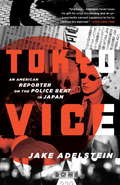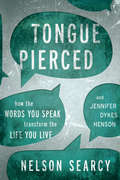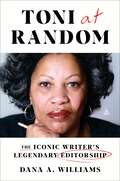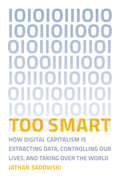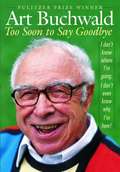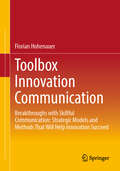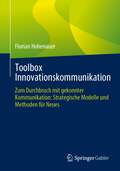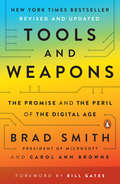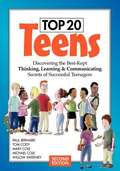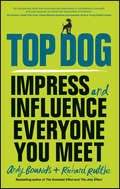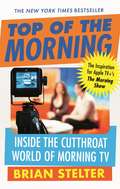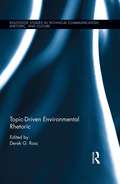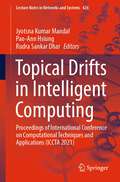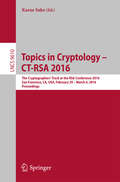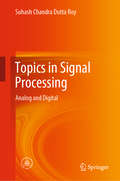- Table View
- List View
Todo por los votos
by Carlos Pacheco Gustavo OnoratoLa historia reciente y la comunicación política vistas a través de recordadas piezas publicitarias. Todo por los votos es una investigación periodística que combina la historia política reciente con las claves de la comunicación política y de la publicidad. "La publicidad es una poderosa herramienta de conocimiento antropológico de las sociedades", afirman los autores. Incluye la reflexión y el testimonio de publicistas, sociólogos y analistas políticos, como Francisco Vernazza, Óscar Bottinelli, Adolfo Garcé, Esteban Valenti, Álvaro Ahunchain, Claudio Invernizzi, José M. Busquets, José L. Costa, José M. Reyes y Gerardo Caetano. Piezas como "la paradoja" (1989), eslóganes como "Batlle le canta la justa" (1994-1999) y "fotos robadas" a José Mujica (2009) son transformadas en el libro en claves para comprender los desafíos a los que se enfrentaron los uruguayos en las últimas décadas. Todo por los votos comienza en 1980 y abarca en total seis elecciones nacionales y dos referéndums. Paso a paso, votación tras votación, el libro responde varias preguntas: ¿la publicidad puede crear un candidato o torcer una elección? ¿Cuál es el papel de los publicistas y cuál el de los candidatos? ¿Cuánto pesa un buen eslogan? ¿Qué rol desempeña la publicidad en una elección cabeza a cabeza? En los dos capítulos finales, los autores reflexionan sobre el perturbador papel de las redes sociales en las campañas políticas y respecto del perfil del votante uruguayo en el Uruguay de hoy, a la vez que se preguntan: ¿aumentó el riesgo de juego sucio? ¿Qué votan los uruguayos?
Together But Something Missing: How to create and sustain successful relationships
by Ben RenshawPower struggles - Lack of communication - Unconscious needs - Fear of rejection - Different interests - Out of date habits - Fear of intimacy - High expectations - Too busy.If even one of these issues causes problems in your relationships, then this book is for you. As Britain's top personal development guru - and married himself - Ben Renshaw is able to throw strong light on what we can all do to improve our relationships, no matter what the problem. In his view there are ten principles of a successful partnership or marriage: Letting go of the past. Knowing what you want to say 'Yes' to. Realising that Now is New. Deciding how you want to be. Fearing less, talking more. Sexual healing. The inevitability of change. Living a life of gratitude. Making love more important than the relationship. Remembering the spirit zone. Full of thoughtful, realistic advice, this is the book no caring, sharing person can afford not to read.
Together We Thrive: How to find your tribe, build a community and create the dream network
by Raphael Sofoluke‘Raphael has an experience few can equal. His book offers a uniquely valuable perspective on how to build thriving communities!’ Steven Bartlett, bestselling author of Diary of a CEOWe live in a world of individualism, where people act in their own interests, striving for their own success. Our focus on self-development means we’ve overlooked a vital and transformative power.In Together We Thrive, Raphael Sofoluke, Founder and CEO behind UK Black Business Show and UK Black Business Week, reveals the immense potential of harnessing a community.You’ll learn how to nurture the connections that will become your currency and build relationships that will fuel your success. Your network speaks louder than you can, amplifies your story, mission and values, and is more resilient than you could ever be on your own. Packed with insights and inspiration from Sofoluke and his own community of highly successful people, Together We Thrive will help you find a tribe of invaluable supporters who will hold you to account and make sure that you reach your full potential.If you want to go far, you have to go together.
Tokyo Vice: An American Reporter on the Police Beat in Japan
by Jake AdelsteinA riveting true-life tale of newspaper noir and Japanese organized crime from an American investigative journalist. Jake Adelstein is the only American journalist ever to have been admitted to the insular Tokyo Metropolitan Police Press Club, where for twelve years he covered the dark side of Japan: extortion, murder, human trafficking, fiscal corruption, and of course, the yakuza. But when his final scoop exposed a scandal that reverberated all the way from the neon soaked streets of Tokyo to the polished Halls of the FBI and resulted in a death threat for him and his family, Adelstein decided to step down. Then, he fought back. In Tokyo Vice he delivers an unprecedented look at Japanese culture and searing memoir about his rise from cub reporter to seasoned journalist with a price on his head.From the Trade Paperback edition.
Tomorrow’s History: Selected Writings of Simon Zadek, 1993-2003
by Simon ZadekThe last ten years have seen an extraordinary transformation in how business has to account for itself. Today, the air is thick with the buzz of corporate responsibility (CR) leaders, innovators and practitioners. Conferences and publications on the topic are in abundance: the tip of an iceberg that has become a fast-growth industry. Many of those companies and service providers most vocal in distancing themselves from early experimentation have proved the strongest advocates of sustainability reporting, often winning applause and coveted awards in the process. Even companies from controversial sectors such as alcohol, cigarettes and gambling have joined the party – running up bills of tens of millions of dollars in demonstrating their new-found faith for CR. It has not always been like this. As one of the architects of the burgeoning CR movement, Simon Zadek has always been a prolific writer and contributor of ideas. The evolution of his thoughts on new economics, corporate accountability, stakeholder dialogue, social and ethical auditing and reporting have attracted consistent attention – never more than today. In this unique anthology, Zadek crystallises his key work from the last decade into a coherent and fascinating whole, which, read together, provide a context, lens and early history lesson on how CR has become one of the defining business issues of the 21st century. The writings reflect Zadek's involvement with organisations such as the New Economics Foundation, a pioneer in the development of social auditing, sustainability indicators, community finance and much more. They illustrate his contribution in setting up the Ethical Trading Initiative, and AccountAbility (where he is presently the CEO), in working with companies such as The Body Shop and Ben & Jerry's through to Nike, BT and many other civil-society organisations. The book contains 33 pieces, which are split into six sections: "The Economics of Utopia"; "Civil Society, Power and Accountability"; "Accounting for Change"; "The Civil Corporation"; "Partnership Alchemy"; and "Responsible Competitiveness". It will be an invaluable resource for anyone wishing develop an understanding of why corporate responsibility is where it is today and where it might end up tomorrow.
Tongue Pierced
by Nelson SearcyWords. They can seem tiny and insignificant, but they have tremendous power. They create our atmosphere, ignite psychological connections, shape our thinking, determine our actions, and ultimately construct our reality. Our words can strengthen relationships or tear people down, lead to success or ruin a lifetime's legacy. Words can truly change our world. It's up to you to determine whether that change will be for better or for worse. The words you allow to flow from your mouth will shape your circumstances. This practical guide will show you how to choose your words wisely in order to create the life you want.Includes the "30-Day No Cursing Challenge."
Toni at Random: The Iconic Writer's Legendary Editorship
by Dana A. WilliamsNPR SPRING PICKAn insightful exploration that unveils the lesser-known dimensions of this legendary writer and her legacy, revealing the cultural icon’s profound impact as a visionary editor who helped define an important period in American publishing and literature.A multifaceted genius, Toni Morrison transcended her role as an author, helping to shape an important period in American publishing and literature as an editor at one of the nation’s most prestigious publishing houses. While Toni Morrison's literary achievements are widely celebrated, her editorial work is little known. Drawing on extensive research and firsthand accounts, this comprehensive study discusses Morrison's remarkable journey from her early days at Random House to her emergence as one of its most important editors. During her tenure in editorial, Morrison refashioned the literary landscape, working with important authors, including Toni Cade Bambara, Leon Forrest, and Lucille Clifton, and empowering cultural icons such as Angela Davis and Muhammad Ali to tell their stories on their own terms.Toni Morrison herself had great enthusiasm about Dana Williams's work on this story, generously sharing memories and thoughts with the author over the years, even giving her the book's title. From the manuscripts she molded, the authors she nurtured, and the readers she inspired, Toni at Random demonstrates how Toni Morrison has influenced American culture beyond the individual titles or authors she published. Morrison’s contribution as an editor transformed the broader literary landscape and deepened the cultural conversation. With unparalleled insight and sensitivity, Toni at Random charts this editorial odyssey.
Too Much Free Speech?
by Randall P. BezansonIn Too Much Free Speech?, Randall P. Bezanson takes up an essential and timely inquiry into the Constitutional limits of the Supreme Court's power to create, interpret, and enforce one of the essential rights of American citizens. Analyzing contemporary Supreme Court decisions from the past fifteen years, Bezanson argues that judicial interpretations have fundamentally and drastically expanded the meaning and understanding of "speech." Bezanson focuses on judgments such as the much-discussed Citizens United case, which granted the full measure of constitutional protection to speech by corporations, and the Doe vs. Reed case in Washington state, which recognized the signing of petitions and voting in elections as acts of free speech. In each case study, he questions whether the meaning of speech has been expanded too far and critically assesses the Supreme Court's methodology in reaching and explaining its expansive conclusions. Bezanson's measured approach and deep insights reveal the complexities of speech in the realms of human behavior and constitutional law. His wide-ranging analysis of relevant Supreme Court cases arms readers with the facts and perspectives necessary to reach independent conclusions about whether the Court's conduct befitted the independent judicial branch and to understand the consequences of its decisions for a representative democracy.
Too Smart: How Digital Capitalism is Extracting Data, Controlling Our Lives, and Taking Over the World (The\mit Press Ser.)
by Jathan SadowskiWho benefits from smart technology? Whose interests are served when we trade our personal data for convenience and connectivity?Smart technology is everywhere: smart umbrellas that light up when rain is in the forecast; smart cars that relieve drivers of the drudgery of driving; smart toothbrushes that send your dental hygiene details to the cloud. Nothing is safe from smartification. In Too Smart, Jathan Sadowski looks at the proliferation of smart stuff in our lives and asks whether the tradeoff—exchanging our personal data for convenience and connectivity—is worth it. Who benefits from smart technology?Sadowski explains how data, once the purview of researchers and policy wonks, has become a form of capital. Smart technology, he argues, is driven by the dual imperatives of digital capitalism: extracting data from, and expanding control over, everything and everybody. He looks at three domains colonized by smart technologies' collection and control systems: the smart self, the smart home, and the smart city. The smart self involves more than self-tracking of steps walked and calories burned; it raises questions about what others do with our data and how they direct our behavior—whether or not we want them to. The smart home collects data about our habits that offer business a window into our domestic spaces. And the smart city, where these systems have space to grow, offers military-grade surveillance capabilities to local authorities. Technology gets smart from our data. We may enjoy the conveniences we get in return (the refrigerator says we're out of milk!), but, Sadowski argues, smart technology advances the interests of corporate technocratic power—and will continue to do so unless we demand oversight and ownership of our data.
Too Soon to Say Goodbye (Thorndike Biography Ser.)
by Art BuchwaldWhen doctors told Art Buchwald that his kidneys were kaput, the renowned humorist declined dialysis and checked into a Washington, D.C., hospice to live out his final days. Months later, "The Man Who Wouldn't Die" was still there, feeling good, holding court in a nonstop "salon" for his family and dozens of famous friends, and confronting things you usually don't talk about before you die; he even jokes about them. Here Buchwald shares not only his remarkable experience--as dozens of old pals from Ethel Kennedy to John Glenn to the Queen of Swaziland join the party--but also his whole wonderful life: his first love, an early brush with death in a foxhole on Eniwetok Atoll, his fourteen champagne years in Paris, fame as a columnist syndicated in hundreds of newspapers, and his incarnation as hospice superstar. Buchwald also shares his sorrows: coping with an absent mother, childhood in a foster home, and separation from his wife, Ann. He plans his funeral (with a priest, a rabbi, and Billy Graham, to cover all the bases) and strategizes how to land a big obituary in The New York Times ("Make sure no head of state or Nobel Prize winner dies on the same day"). He describes how he and a few of his famous friends finagled cut-rate burial plots on Martha's Vineyard and how he acquired a Picasso drawing without really trying. What we have here is a national treasure, the complete Buchwald, uncertain of where the next days or weeks may take him but unfazed by the inevitable, living life to the fullest, with frankness, dignity, and humor. "[Art Buchwald] has given his friends, their families, and his audiences so many laughs and so much joy through the years that that alone would be an enduring legacy. But Art has never been just about the quick laugh. His humor is a road map to essential truths and insights that might otherwise have eluded us." -Tom Brokaw.
Toolbox Innovation Communication: Breakthroughs with Skillful Communication: Strategic Models and Methods That Will Help Innovation Succeed
by Florian HohenauerThis book offers a toolbox of models and methods that make innovative ideas successful. Innovation brings progress, competitive advantages, and increases profits. However, innovation also always entails uncertainty and provokes defensive reactions, which is why strong communication skills are needed to overcome internal and external hurdles. Successful innovation communication creates awareness and builds necessary knowledge among all key stakeholders. It is fast, flexible, and pragmatic, anticipates resistance, addresses possible negative impacts, and builds bridges to the future. Florian Hohenauer's book is aimed at communication professionals and those who aspire to become one—especially all those who want to develop sustainable communication strategies and are willing to invest a little more time to establish a strong foundation for them. Renowned experts Christine Dingler, Gudrun Herrmann, Sascha Pallenberg, Christiane Schulz, Gerrit Gericke, and Danijel Višević present their own strategic approaches in guest contributions and interviews. Practical examples illustrate the application of the tools presented.
Toolbox Innovationskommunikation: Zum Durchbruch mit gekonnter Kommunikation: Strategische Modelle und Methoden für Neues
by Florian HohenauerDieses Buch bietet eine Werkzeugkiste an Modellen und Methoden, die innovative Ideen erfolgreich machen. Innovation bringt Fortschritt, Wettbewerbsvorteile und steigert die Gewinne. Innovation bedeutet aber auch immer Unsicherheit und ruft Abwehrreaktionen hervor, weshalb starke Kommunikationskompetenzen gefragt sind, um interne und externe Hürden zu überwinden. Gelungene Innovationskommunikation schafft Aufmerksamkeit und baut notwendiges Wissen bei allen wichtigen Stakeholdern auf. Sie ist schnell, flexibel und pragmatisch, antizipiert Widerstände, adressiert mögliche negative Auswirkungen und baut Brücken in die Zukunft.Florian Hohenauers Buch richtet sich an Kommunikationsprofis und solche, die es werden wollen – vor allem an all diejenigen, die nachhaltige Kommunikationsstrategien entwickeln möchten und bereit sind, für deren starkes Fundament etwas mehr Zeit zu investieren. Die renommierten Expert:innen Christine Dingler, Gudrun Herrmann, Dr. Kerstin Hoffmann, Sascha Pallenberg, Christiane Schulz und Gerrit Gericke sowie Danijel Višević stellen in Gastbeiträgen und Interviews eigene strategische Ansätze vor. Praxisbeispiele illustrieren die Anwendung der vorgestellten Werkzeuge.
Toolbox Kommunikationsmanagement: Denkwerkzeuge und Methoden für die Steuerung der Unternehmenskommunikation
by Ansgar Zerfaß Sophia Charlotte VolkErfahren Sie in diesem Buch Wissenswertes rund um das Thema strategische Unternehmenskommunikation Dieses Buch gibt einen umfassenden Überblick zu bestehenden Ansätzen, Methoden und Instrumenten für das strategische Kommunikationsmanagement in Unternehmen. Es behandelt die folgenden Themenbereiche:Der Beitrag von Kommunikation zur WertschöpfungToolbox für das Kommunikationsmanagement: Analysetools, Planungstools, Umsetzungstools, EvaluationstoolsNeue Tools für das KommunikationsmanagementAnwendungsbeispiele für die ToolboxTop-Tools und ErfolgsfaktorenWeiterhin werden im Buch „Toolbox Kommunikationsmanagement - Denkwerkzeuge für die Steuerung der Unternehmenskommunikation“ aktuelle Erkenntnisse aus der internationalen Forschung neu systematisiert und mit empirischen Daten sowie Best-Practice-Beispielen aus der Kommunikationspraxis von Unternehmen in Deutschland verknüpft. Erfolgreiche Kommunikationschefs berichten darüber hinaus über ihre eigenen Erfahrungen und praktische Lösungsansätze. Ein optimaler Wegweiser für Unternehmensleitung und KommunikationsverantwortlicheAnsgar Zerfaß und Sophia Charlotte Volk stellen konkrete Tools zum Management der Kommunikation vor und wenden sich damit an alle, die den Beitrag der Unternehmenskommunikation zum Organisationserfolg ganzheitlich verstehen und steuern wollen. Die in diesem Buch erwähnten Tools sind zum Beispiel: Communication-Touchpoint-AnalyseZieleradar Sentiment-AnalyseCommunication Value Circle MaßnahmenportfolioIssue MapsCommunication ScrumMit dieser umfassenden Betrachtung des Kommunikationsmanagements richtet sich dieser praktische Wegweiser in erster Linie an die Unternehmensleitung und an Kommunikationsverantwortliche.
Tools and Weapons: The Promise and the Peril of the Digital Age
by Brad Smith Carol Browne<P><P>From Microsoft's president and one of the tech industry's broadest thinkers, a frank and thoughtful reckoning with how to balance enormous promise and existential risk as the digitization of everything accelerates.Microsoft President Brad Smith operates by a simple core belief: When your technology changes the world, you bear a responsibility to help address the world you have helped create. <P><P>This might seem uncontroversial, but it flies in the face of a tech sector long obsessed with rapid growth and sometimes on disruption as an end in itself. While sweeping digital transformation holds great promise, we have reached an inflection point. The world has turned information technology into both a powerful tool and a formidable weapon, and new approaches are needed to manage an era defined by even more powerful inventions like artificial intelligence. <P><P>Companies that create technology must accept greater responsibility for the future, and governments will need to regulate technology by moving faster and catching up with the pace of innovation. <P><P>In Tools and Weapons, Brad Smith and Carol Ann Browne bring us a captivating narrative from the cockpit of one of the world's largest and most powerful tech companies as it finds itself in the middle of some of the thorniest emerging issues of our time. These are challenges that come with no preexisting playbook, including privacy, cybercrime and cyberwar, social media, the moral conundrums of artificial intelligence, big tech's relationship to inequality, and the challenges for democracy, far and near. <P><P>While in no way a self-glorifying "Microsoft memoir," the book pulls back the curtain remarkably wide onto some of the company's most crucial recent decision points as it strives to protect the hopes technology offers against the very real threats it also presents. There are huge ramifications for communities and countries, and Brad Smith provides a thoughtful and urgent contribution to that effort. <P><P><b>A New York Times Bestseller</b>
Tools of Transport Telematics
by Jerzy MikulskiThis book constitutes the proceedings of the 15th International Conference on Transport Systems Telematics, TST 2015, held in Wrocław, Poland, in April 2015. The 35 revised full papers and two short papers included in this volume were carefully reviewed and selected from 115 submissions. The papers provide an overview of solutions being developed in the fields of transport telematics and intelligent transport systems.
Top 20 Teens: Discovering the Best-Kept Thinking, Learning and Communicating Secrets of Successful Teenagers (2nd Edition)
by Michael Cole Paul Bernabei Tom Cody Mary Cole Willow SweeneyApplication of the principles discussed in this book could result in you making a positive difference in your life and the lives of others! <p>All teens have the potential to become difference makers, to create meaningful and successful experiences for themselves and others However, not all teens know they have this power. That's where this book comes in. <p>Developed by a team of students, parents and educators, Top 20 Teens presents the Thinking, Learning and Communicating skills of the Top 20, the difference makers. By applying these skills in your personal relationships and school experiences, you can become the author of your life's story rather than just a character in it.
Top Dog
by Andy Bounds Richard RuttleGet the results you want and come out as the Top Dog in everyconversationFancy being the 'Top Dog' in all your dealings? Fedup of feeling like the underdog? So many of us regularly'lose' in conversations before we've even openedour mouths? Often without realising it, we don't seeourselves as a peer of the other person. And we transmit this inwhat we do and say ("I'll fit round you. I knowyou're really busy.") The other person picks up onthis. And, without doing a thing, they're suddenly incharge!Top Dog will teach you how to lead in all your interactions, so youcan get more of what you want, more often.Together, Andy Bounds and Richard Ruttle are experts at helpingpeople achieve more from their conversations with others. Theirtechniques work in every type of interaction--conversations,socialising, dating, interviews, sales, marketing, and networking.Basically, anytime you want to impress and persuade others.Top Dog:* Details the skill set needed to gain competitiveadvantage from the outset * Provides instructive and thought-provoking content,relevant to both beginners, and seasoned professionals* Contains insights from working with some of theworld's largest companies* Addresses how to achieve more from interactions inbusiness and social arenas
Top of the Morning: The Inspiration for Apple TV's THE MORNING SHOW
by Brian StelterDiscover the cutthroat world behind the polite smiles and perky demeanors of morning news in the book that inspired the Apple TV series starring Reese Witherspoon, Jennifer Aniston, and Steve Carrell.When America wakes up with personable and charming TV hosts, it's hard to imagine their show bookers having to guard a guest's hotel room all night to prevent rival shows from poaching. But that is just a glimpse of the intense reality revealed in this gripping look into the most competitive time slot in television.Featuring exclusive content about all the major players in American morning television, the book illuminates what it takes to win the AM -- when every single viewer counts, tons of jobs are on the line, and hundreds of millions of dollars are at stake. Author Brian Stelter is behind the scenes as Ann Curry replaces Meredith Vieira on the Today show, only to be fired a year later in a fiasco that made national headlines. He's backstage as Good Morning America launches an attack to dethrone Today and end the longest consecutive winning streak in morning television history. And he's there as Roberts is diagnosed with a crippling disease -- on what should be the happiest day of her career.So grab a cup of coffee, sit back, and discover the dark side of the sun.PRAISE FOR TOP OF THE MORNING"Mr. Stelter pulls back the curtains and exposes a savage corporate world that might have been inhabited by the Sopranos." - Washington Times"A troubling look inside an enterprise as vicious and internecine as a soap opera." - Kirkus Reviews
Topic-Driven Environmental Rhetoric (Routledge Studies in Technical Communication, Rhetoric, and Culture)
by Derek G. RossCommon topics and commonplaces help develop arguments and shape understanding. When used in argumentation, they may help interested parties more effectively communicate valuable information. The purpose of this edited collection on topics of environmental rhetoric is to fill gaps in scholarship related to specific, targeted, topical communication tactics. The chapters in this collection address four overarching areas of common topics in technical communication and environmental rhetoric: framing, place, risk and uncertainty, and sustainability. In addressing these issues, this collection offers insights for students and scholars of rhetoric, as well as for environmental communication practitioners looking for a more nuanced understanding of how topic-driven rhetoric shapes attitudes, beliefs, and decision-making.
Topical Drifts in Intelligent Computing: Proceedings of International Conference on Computational Techniques and Applications (ICCTA 2021) (Lecture Notes in Networks and Systems #426)
by Jyotsna Kumar Mandal Pao-Ann Hsiung Rudra Sankar DharThis book gathers a collection of high-quality peer-reviewed research papers presented at International Conference on Computational Techniques and Applications (ICCTA 2021), organized by the Electronics and Telecommunication Engineers (IETE), Kolkata Center, India, during 8 – 9 October 2021. This includes research in the areas of intelligent computing and communication systems including computing, electronics, green energy design, communications, computers to interact and disseminate information on latest developments both academically and industrially for computational drifts. The three main tracks are (i) computing in network security, AI and data science; (ii) contemporary issues in electronics, and communication technology; and (iii) intelligent computing in electrical power, control systems and energy technology.
Topics in Cryptology - CT-RSA 2016
by Kazue SakoThisbook constitutes the refereed proceedings of the Cryptographer's Track at theRSA Conference 2016, CT-RSA 2016, held in San Francisco, CA, USA, in February/March2016. The26 papers presented in this volume were carefully reviewed and selected from 76submissions. The focus of the track is on following subjects: secure keyexchange schemes, authenticated encryption, searchable symmetric encryption,digital signatures with new functionality, secure multi party computation, howto verify procedures, side-channel attacks on elliptic curve cryptography, hardwareattacks and security, structure-preserving signatures, lattice cryptography, cryptanalysisof symmetric key encryption, message authentication code and PRF-security, and securityof public key encryption.
Topics in Signal Processing: Analog and Digital
by Suhash Chandra Dutta RoyThis book is a collection of specific research problems in signal processing and their solutions. It touches upon most core topics, including active and passive processing, discrete-time and continuous signals, and design of filters and networks for specific applications. This unique collection of design problems and conceptual insights will be useful to graduate students, researchers, and professionals working on signal processing problems. In addition, the book can also be used as a supplementary text for graduate courses in advanced signal processing, and for professional development courses for practicing engineers.
Topics in Spanish Linguistic Perceptions (Routledge Studies in Hispanic and Lusophone Linguistics)
by Ortiz-López, Luis AlfredoTopics in Spanish Linguistic Perceptions brings together the most current research on linguistic perceptions of varieties of Spanish. The book includes articles from a range of expert contributors using different methodologies and looking at diverse sociolinguistic settings. Readers will gain a rich understanding of the importance of linguistic perceptions and the societal attitudes they are linked to. Readers will also gain insight into the interplay between socioeconomic groups, and educational and linguistic norms and the perception of non-standardized forms of Spanish. The volume highlights the relationship between language and social perceptions and will be of particular interest to researchers and students in Hispanic linguistics, sociophonetics, and sociolinguistics.
Topics, Questions, Key Words: A Handbook for Students of German
by Paul Jackson Petra HachenburgerIntermediate students and their teachers will find this compact manual an invaluable resource for essay-writing and debate in German. Thirty sections provide questions and vocabulary on a range of contemporary issues guaranteed to stimulate thought and discussion. Includes introductory notes on approaches to group work and writing strategies. Topics include:*computers*the environment*young people*war and peace*the third world
Total Journalism: Models, Techniques and Challenges (Studies in Big Data #97)
by Xosé López-García Jorge Vázquez-Herrero Alba Silva-Rodríguez Carlos Toural-Bran María-Cruz Negreira-ReyThis book aims to explore the diverse landscape of journalism in the third decade of the twenty-first century, constantly changing and still dealing with the consequences of a global pandemic. ‘Total journalism’ is the concept that refers to the renewed and current journalism that employs all available techniques, technologies, and platforms.Authors discuss the innovative nature of journalism, the influence of big data and information disorders, models, professionals and audiences, as well as the challenges of artificial intelligence. The book gives an up-to-date overview of these perspectives on journalistic production and distribution. The effects of misinformation and the challenge of artificial intelligence are of specific relevance in this book.Readers can enjoy with contributions from prestigious experts and researchers who make this book an interesting resource for media professionals and researchers in media and communication studies.



